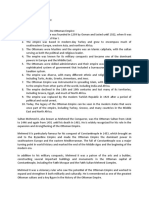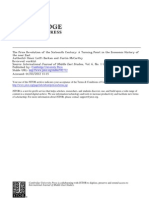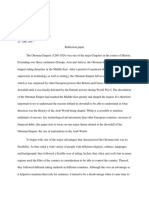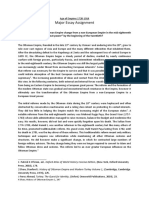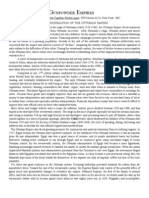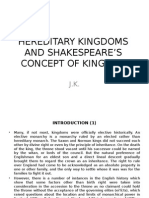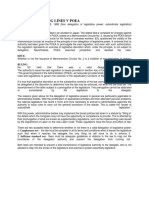Paper 3
Uploaded by
api-245514641Paper 3
Uploaded by
api-245514641Adel Alotaibi Aalotai7@gmu.
edu
Results of the Fall of the Ottoman Empire In the nineteenth century, the Ottoman Empire, which had strongly and effectively ruled a large area of the Islamic world, began to collapse. It gradually began to lose its territories in North Africa as well as the Balkans to other powerful European powers and nationalist movements. The lost of its territories is also attributed to a growth in the culture and economy of many parts in the Middle East. European imperialism further weakened the already declining Ottoman Empire. By the beginning of the First World War, the once large and powerful Ottoman Empire had been reduced to a small and less powerful empire made up of Turkey, Syria, Palestine and the Arabian Peninsula. Eventually, the Ottoman Empire collapsed completely. For a better understanding of the results of the fall of the Ottoman Empire, it is important to have an overview of the reason that contributed to the collapse of this empire. In this regard, there is a wide range of factors that led to the collapse of the Ottoman Empire. These factors range from administrative, military and religious causes. In regard to economic factors, the fall of the Ottoman Empire is largely attributed to the empires failed economic structure. The economy of the empire was based on agriculture. In the wake of industrial revolution, the Ottoman Empire failed to embrace industrialization and technological advancement. Consequently, it became economically isolated. Due to its lack of industrialization, the dependence on agriculture became unreliable. The collapsing economy ignited widespread unrests among the people in the empire. Eventually, it lost its control, especially after the Greek revolution. The Ottoman Empire also failed to withstand stiff competition from other European powers. It was
Adel Alotaibi Aalotai7@gmu.edu
marred by other economic hardships including high unemployment rates and increased inflation. The development of alternative trade routes also hurt the economy of the empire. With this staggering economic structure, the Ottoman Empire could not withstand pressure and it eventful collapsed. In addition, the empire was also marred by administrative challenges. It became more and more decentralized and therefore lost its central control. In addition, the rules became complacent in regard to maintaining integrity and effectiveness in the administration of the empire. The leaders were also corrupt and perpetrated other unethical practices. Finally, the collapse of the Ottoman Empire has largely been attributed to the rise of European imperialism. At this juncture, it is important to analyze the results of the ultimate fall of the Ottoman Empire. First and foremost, thus significantly altered the organization and governance of the Middle East. For many centuries, the Ottoman Empire had unified many counties in the Islamic world, especially in the Middle East and North Africa. Under the Ottoman control, Turkey had become more of a power base for the Ottoman Empire. It acted as central point through which the larger Islamic world was governed. The collapse of the Ottoman Empire implied an end to the unification of the Islamic world. In the aftermath of the fall of the empires, the Ottomans were replaced by foreign powers. As a result, the once unified Islamic world under the Ottoman became fragmented. Another effect of the fall of Ottoman Empire is that European powers began to exert their power over the region directly. For instance, the British began to exert its power over some of the countries previously under by the Ottoman Empire. It began to
Adel Alotaibi Aalotai7@gmu.edu
directly colonize Egypt. The British also took control of Gulf and the Suez Canal. Its inexorable interest in the Suez Canal was because of its link to Iran and India. Other European powers that took control of the Ottoman Empire include France and Germany. For instance, France took over Lebanon. Thirdly, the collapse of the Ottoman Empire led to the emergence and spread of nationalism in the Middle East. During the Ottoman reign, the Islamic world was unified. However, following its collapse, there was a rise in nationalists movement in various countries in the Middle East. Many scholars contend that the fall of the Ottomans Empire ignited the widespread nationalist sentiments that characterized the Middle East and North African regions. Some counties such as Turkey and Yemen gained their independence. The formation of many countries in the Middle East occurred in the aftermath of the collapse of the Ottoman Empire. Thus, historians contend that besides instigating nationalism, the collapse of the Ottoman Empire led to the formation of many counties in the Middle East. These include Lebanon, Turkey, Syria, and Yemen. The fall of the Ottoman Empire negatively affected the economy of the region. When the empire was on the verge of collapse, it was characterized by a very weak economy. There was a drastic decrease in trading activities. Many European opted to trade directly with Asia leaving the Middle East. The silver-based monetary system that had been established by the Ottoman Empire also affected the economy. By the time of its collapse, there was the discovery other metals. As a result, there was a sudden supply of cheap silver. This posed a major threat to the economy of the regions in the Ottoman Empire. In addition, raw materials from the countries in the Middle East became cheaper.
Adel Alotaibi Aalotai7@gmu.edu
This also presented grave economic consequences to the region in the Middle East in the aftermath of the collapse of the Ottoman Empire. On the positive front, the collapse of the Ottoman Empire had long-lasting effects in the military of the counties in the Middle East and North Africa. Throughout its reign, the Ottoman Empire used top-notch military techniques. This significantly contributed to its expansion. Stearns (351) contends that the Ottoman military was one of the greatest and most dormant in the world especially between 1300 and 1700s. The success of this empire has often been linked to its excellent military. For instance, the Ottoman military was the first in the world to use canons and muskets. Indeed, the Ottoman military was more of a professional institution. The Sultan paid the soldiers. After the collapse of this empire, the countries in the region inherited the old Ottoman army. The legacy of the Ottoman army is still evident in the Turkish and Egyptian army. They have been rated as one of the largest and competent armies in the world. In conclusion, the collapse of the Ottoman Empire is a attributed to a wide range of factors. These include the collapse of the economy, military conquests, spread of European imperialism and poor administration among others. Evidently, the fall of this empire had many impacts. It led to the disintegration of the Middle East and North African regions. In addition, it led to the growth of nationalism and establishment of new counties. Also, the fall was detrimental to the economy of the region. Finally, the collapse of the Ottoman Empire left a long lasting effect on the military of the counties in the Middle East region.
Adel Alotaibi Aalotai7@gmu.edu
Works Cited Stearns, Peter N. World in Brief: Major Patterns of Change and Continuity since 1450.
You might also like
- Week 2 His101 History of Turkish Revolution and Ataturk's Principles INo ratings yetWeek 2 His101 History of Turkish Revolution and Ataturk's Principles I6 pages
- THE OTTOMAN EMPIRE by Cherif?? Last WorkNo ratings yetTHE OTTOMAN EMPIRE by Cherif?? Last Work11 pages
- The Price Revolution of The Sixteenth Century - BarkanNo ratings yetThe Price Revolution of The Sixteenth Century - Barkan27 pages
- Decline and modernization of the Ottoman EmpireNo ratings yetDecline and modernization of the Ottoman Empire20 pages
- Ottoman Dress and Design in the West: A Visual History of Cultural ExchangeFrom EverandOttoman Dress and Design in the West: A Visual History of Cultural Exchange2/5 (1)
- The Contribution of Sultan Muhammad Al-Fateh91% (11)The Contribution of Sultan Muhammad Al-Fateh11 pages
- Ottoman Empire: An Enthralling Guide to One of the Mightiest (An Enthralling Overview of the Rise and Fall of the Ottoman Empire)From EverandOttoman Empire: An Enthralling Guide to One of the Mightiest (An Enthralling Overview of the Rise and Fall of the Ottoman Empire)No ratings yet
- A-History-of-Muslim-Philosophy-Volume-1-Book-2-by-M.-M.-SHARIFNo ratings yetA-History-of-Muslim-Philosophy-Volume-1-Book-2-by-M.-M.-SHARIF31 pages
- Lewis Some Reflections On The Decline of The Ottoman EmpireNo ratings yetLewis Some Reflections On The Decline of The Ottoman Empire18 pages
- The Evolution of Fiscal Institutions in The Ottoman Empire, 1500-1914No ratings yetThe Evolution of Fiscal Institutions in The Ottoman Empire, 1500-191440 pages
- Analyze The Reforms of Sultan Selim III. International Ataturk Alatoo University0% (1)Analyze The Reforms of Sultan Selim III. International Ataturk Alatoo University2 pages
- Changes in Factor Markets in The Ottoman Empire, 1500-1800: F Cambridge University Press 2009No ratings yetChanges in Factor Markets in The Ottoman Empire, 1500-1800: F Cambridge University Press 200931 pages
- OSMANLININ_SON_DONEMININ_SOSYO_EKONOMIKNo ratings yetOSMANLININ_SON_DONEMININ_SOSYO_EKONOMIK23 pages
- Modern Muslim World: BAHU3073 Session 3No ratings yetModern Muslim World: BAHU3073 Session 314 pages
- President Zviad K. Gamsakhurdia (1939-1993)100% (2)President Zviad K. Gamsakhurdia (1939-1993)25 pages
- Instant Ebooks Textbook (Original PDF) Canadian Democracy A Concise Introduction Download All Chapters100% (3)Instant Ebooks Textbook (Original PDF) Canadian Democracy A Concise Introduction Download All Chapters27 pages
- AL-Sen: Voter Surveys & Consulting For The Senate Leadership Fund (Aug 2017)No ratings yetAL-Sen: Voter Surveys & Consulting For The Senate Leadership Fund (Aug 2017)1 page
- HAFTECK 2003 - Decentralized Cooperation PDFNo ratings yetHAFTECK 2003 - Decentralized Cooperation PDF13 pages
- City Considers Electronic Signs On Highway 101: Rruussssiiaann SsttoorrmmNo ratings yetCity Considers Electronic Signs On Highway 101: Rruussssiiaann Ssttoorrmm32 pages
- Apocalyptic Feminism Adam Mickiewicz and Margaret FullerNo ratings yetApocalyptic Feminism Adam Mickiewicz and Margaret Fuller39 pages
- Aug. 25, 2018 Draft Proposed Regulations For Reinterpreting Title IXNo ratings yetAug. 25, 2018 Draft Proposed Regulations For Reinterpreting Title IX10 pages
- This Content Downloaded From 194.230.141.102 On Sun, 02 Jan 2022 12:33:07 UTCNo ratings yetThis Content Downloaded From 194.230.141.102 On Sun, 02 Jan 2022 12:33:07 UTC36 pages
- U.S. Embassy Cable On Pfizer Clinical Trials On Children, Their Murders and SettlementNo ratings yetU.S. Embassy Cable On Pfizer Clinical Trials On Children, Their Murders and Settlement5 pages
- 15LFW WorkingWithMulticulturalTeams LarsonC PDFNo ratings yet15LFW WorkingWithMulticulturalTeams LarsonC PDF33 pages
- Week 2 His101 History of Turkish Revolution and Ataturk's Principles IWeek 2 His101 History of Turkish Revolution and Ataturk's Principles I
- The Price Revolution of The Sixteenth Century - BarkanThe Price Revolution of The Sixteenth Century - Barkan
- Turning Points - Events That Shaped The Modern WorldFrom EverandTurning Points - Events That Shaped The Modern World
- Ottoman Dress and Design in the West: A Visual History of Cultural ExchangeFrom EverandOttoman Dress and Design in the West: A Visual History of Cultural Exchange
- Ottoman Empire: An Enthralling Guide to One of the Mightiest (An Enthralling Overview of the Rise and Fall of the Ottoman Empire)From EverandOttoman Empire: An Enthralling Guide to One of the Mightiest (An Enthralling Overview of the Rise and Fall of the Ottoman Empire)
- A-History-of-Muslim-Philosophy-Volume-1-Book-2-by-M.-M.-SHARIFA-History-of-Muslim-Philosophy-Volume-1-Book-2-by-M.-M.-SHARIF
- Lewis Some Reflections On The Decline of The Ottoman EmpireLewis Some Reflections On The Decline of The Ottoman Empire
- The Evolution of Fiscal Institutions in The Ottoman Empire, 1500-1914The Evolution of Fiscal Institutions in The Ottoman Empire, 1500-1914
- Analyze The Reforms of Sultan Selim III. International Ataturk Alatoo UniversityAnalyze The Reforms of Sultan Selim III. International Ataturk Alatoo University
- Changes in Factor Markets in The Ottoman Empire, 1500-1800: F Cambridge University Press 2009Changes in Factor Markets in The Ottoman Empire, 1500-1800: F Cambridge University Press 2009
- HISTORICAL CYCLES DECLINE RENEWAL AND LESSON AND TODAY.From EverandHISTORICAL CYCLES DECLINE RENEWAL AND LESSON AND TODAY.
- Instant Ebooks Textbook (Original PDF) Canadian Democracy A Concise Introduction Download All ChaptersInstant Ebooks Textbook (Original PDF) Canadian Democracy A Concise Introduction Download All Chapters
- AL-Sen: Voter Surveys & Consulting For The Senate Leadership Fund (Aug 2017)AL-Sen: Voter Surveys & Consulting For The Senate Leadership Fund (Aug 2017)
- City Considers Electronic Signs On Highway 101: Rruussssiiaann SsttoorrmmCity Considers Electronic Signs On Highway 101: Rruussssiiaann Ssttoorrmm
- Apocalyptic Feminism Adam Mickiewicz and Margaret FullerApocalyptic Feminism Adam Mickiewicz and Margaret Fuller
- Aug. 25, 2018 Draft Proposed Regulations For Reinterpreting Title IXAug. 25, 2018 Draft Proposed Regulations For Reinterpreting Title IX
- This Content Downloaded From 194.230.141.102 On Sun, 02 Jan 2022 12:33:07 UTCThis Content Downloaded From 194.230.141.102 On Sun, 02 Jan 2022 12:33:07 UTC
- U.S. Embassy Cable On Pfizer Clinical Trials On Children, Their Murders and SettlementU.S. Embassy Cable On Pfizer Clinical Trials On Children, Their Murders and Settlement







